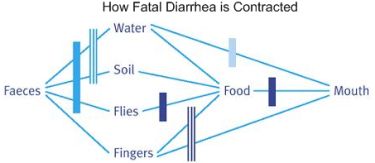
- I like the approach: attacking all of the many sources of contamination (see diagram) rather than focusing narrowly on water.
- It’s been done before, with potentially encouraging results (see page 9). I haven’t seen enough on it to call it a “proven” approach, but it might be.
- It may be significantly more cost-effective than other approaches to sanitation (see page 21), as it focuses on behavior rather than infrastructure.
- It’s now being replicated in many areas; that implies that there’s a process in place for replication, and that more funds could result in more people reached.
But I can’t find out how to fund it.
The program’s summary page links to three organizations. One appears devoted to research rather than replication. Another is a water and sanitation omnibus program whose activities include many of the activities I’m less confident in. CLTS is nowhere on its list of global initiatives. The third organization is CARE, a giant organization whose website barely mentions CLTS (and its only use of the program appears to be as an “entry point” to other programs).
We think programs that are proven, cost-effective and scalable should be popular. But in many cases, there isn’t even a mechanism for this to happen – some of the most promising interventions aren’t even on a donor’s menu.

Comments
Why don’t you email the author of the page (seems to be p.bongartz@ids.ac.uk) and ask if she has any suggestions?
Comments are closed.